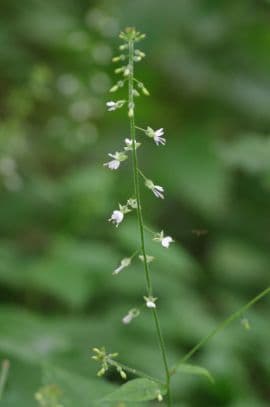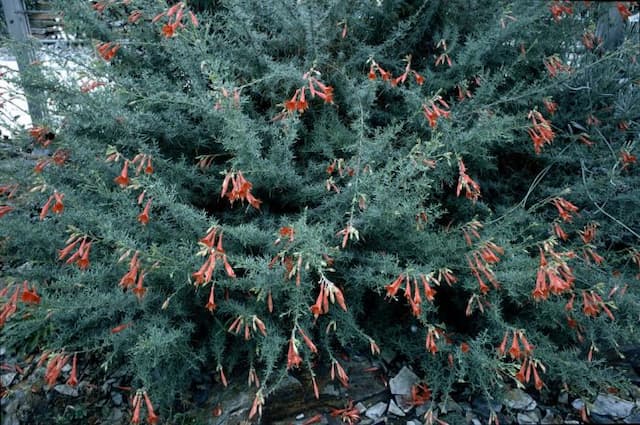Fuchsia Fuchsia 'Frosted Flame'

ABOUT
Fuchsia 'Frosted Flame' is recognized for its striking and vividly colored flowers and attractive foliage. The flowers of this Fuchsia variety are unique and quite showy, often described as having a two-toned appearance. They typically feature a beautiful combination of pink and purple hues, with the petals being pink and the sepals, which are the outer parts of the flowers, boasting a lighter, almost frosty shade of pinkish-purple. The form of the flower is particularly distinctive; it hangs elegantly from the stems and branches, resembling dainty lanterns or ballerinas with their skirts lifted in a dance. The petals curl back, creating a pleasing and graceful look, while the long, protruding stamens add an extra flair of decoration to the already charming flower structure. In addition to its showy flowers, Fuchsia 'Frosted Flame' possesses attractive foliage that offers a pleasing contrast and backdrop to its blooms. The leaves are typically dark green in color, and each leaf can have a slight reddish-purple tint along the edges and veins, which only enhances the overall ornamental appeal of the plant. This reddish margin sometimes creates the illusion of a delicate frosting on the foliage itself, which ties in with the 'Frosted Flame' moniker. Overall, the aesthetic of Fuchsia 'Frosted Flame' is one of beauty and distinction, making it a popular choice for gardeners and plant enthusiasts who wish to add a vivid and decorative touch to their garden displays, hanging baskets, or containers. Its striking color combination and elegant flower shape ensure that it catches the eye and becomes a focal point wherever it is planted.
About this plant
 Names
NamesFamily
Onagraceae
Synonyms
Ladies' Eardrops, Hummingbird Fuchsia, Hardy Fuchsia
Common names
Fuchsia 'Frosted Flame'.
 Toxicity
ToxicityTo humans
Fuchsia 'Frosted Flame', commonly known as Fuchsia, is not considered toxic to humans. Typically, consuming parts of the plant doesn't lead to serious poisoning. However, as with any non-food plant, sensitivity to the plant can vary among individuals, and ingesting the plant might cause mild gastrointestinal discomfort in some cases. Always exercise caution and keep plants out of reach of small children who might accidentally ingest plant parts.
To pets
Fuchsia 'Frosted Flame', mostly known simply as Fuchsia, is generally not toxic to pets such as dogs and cats. It is not listed among the plants that pose a significant risk of poisoning to pets. Nevertheless, if a pet ingests a large quantity of the plant, it might experience mild gastrointestinal upset. If any unusual symptoms arise after your pet has ingested parts of the plant, it is advisable to consult a veterinarian.
 Characteristics
CharacteristicsLife cycle
Perennials
Foliage type
Deciduous
Color of leaves
Variegated
Flower color
Mixed
Height
1-2 feet (30-60 cm)
Spread
1-2 feet (30-60 cm)
Plant type
Shrub
Hardiness zones
9
Native area
Central America
Benefits
 General Benefits
General Benefits- Vibrant Flowers: Fuchsia 'Frosted Flame' produces beautiful, pendulous flowers that are a striking combination of pink, purple, and white, adding a splash of color to any garden.
- Attracts Pollinators: The plant is known to attract hummingbirds and butterflies which helps with pollination and adds life to the garden.
- Extended Blooming Period: This cultivar often has a long flowering season extending from spring to fall, providing prolonged visual interest.
- Versatility: Fuchsias can be grown in pots, hanging baskets, or borders, making them suitable for various garden designs and spaces.
- Shade Tolerance: Unlike many flowering plants, Fuchsia 'Frosted Flame' can thrive in partially shaded conditions, where other plants might struggle to bloom.
- Easy Propagation: Fuchsias can be relatively easy to propagate from cuttings, allowing gardeners to easily increase their stock of plants.
 Medical Properties
Medical PropertiesThis plant is not used for medical purposes.
 Air-purifying Qualities
Air-purifying QualitiesThis plant is not specifically known for air purifying qualities.
 Other Uses
Other Uses- Culinary Garnish: The edible flowers of the Fuchsia 'Frosted Flame' can add a splash of color to salads or desserts, providing a decorative and edible ornamental touch.
- Colorant: Flowers can be used to produce a natural dye for fabrics or art projects, providing a pinkish or purplish hue.
- Photography: The striking flowers of the Fuchsia 'Frosted Flame' make it an excellent subject for botanical photography, bringing attention to the beauty of garden plants.
- Teaching Tool: Can be used in educational settings for botany classes to demonstrate plant growth habits and flower structures.
- Bonsai: Can be trained into a bonsai form, making an attractive and somewhat unusual miniature tree for enthusiasts.
- Butterfly Garden: Its vibrant flowers may attract butterflies, making it a great addition to butterfly gardens.
- Art Inspiration: Artists may use the unique form and color of the Fuchsia 'Frosted Flame' as inspiration in their artwork, particularly in botanical illustrations.
- Container Gardening: Works well in hanging baskets and containers where its trailing habit can be showcased on balconies or patios.
- Thematic Landscapes: Planting Fuchsia 'Frosted Flame' can contribute to a cottage garden theme or a romantic landscape design with its delicate blossoms.
- Wedding Decor: Due to its graceful appearance, the Fuchsia 'Frosted Flame' can be included in floral arrangements for weddings or other formal events.
Interesting Facts
 Feng Shui
Feng ShuiThe Fuchsia is not used in Feng Shui practice.
 Zodiac Sign Compitability
Zodiac Sign CompitabilityThe Fuchsia is not used in astrology practice.
 Plant Symbolism
Plant Symbolism- Confiding Love: Fuchsia is often associated with confiding love. Its hanging blossoms can be seen as a delicate and intimate embellishments that mirror the intricacies of deep affection.
- Elegance and Good Taste: The elegant design of the 'Frosted Flame' Fuchsia, with its distinctive color gradients, is often linked to a notion of sophistication and refined beauty.
- Amiability: Fuchsia flowers are symbolic of amiability or friendliness, potentially due to their welcoming appearance and the inviting manner in which they present their petals to pollinators.
- Ardent Love: The rich colors and vigorous growth of the 'Frosted Flame' variety can indicate a passionate and lively love.
- Trustworthy: The reliable blooming of fuchsias throughout the growing season may also symbolize trustworthiness, suggesting dependability within relationships or friendships.
 Water
WaterThe Fuchsia 'Frosted Flame', commonly known as hardy fuchsia, should be watered deeply whenever the top inch of soil feels dry to the touch. This typically means watering once or twice a week, depending on climate conditions and plant size. Use enough water to soak the root zone; for a potted plant, this might be around 16-32 ounces depending on the pot size and soil dryness. During hotter, drier periods, they may require more frequent watering, but be careful not to overwater, as fuchsias do not like to sit in soggy soil. Always check the soil moisture before watering to ensure it is needed.
 Light
LightHardy fuchsias prefer bright, indirect light and should be placed in a location where they are protected from the harsh afternoon sun. They thrive in partial shade, such as under a tree or on an east-facing patio where they can receive morning sunlight and afternoon shade. Avoid deep shade, as this can reduce blooming and cause leggy growth. Optimal lighting helps maintain vibrant foliage and ample blooms.
 Temperature
TemperatureHardy fuchsias grow best in cooler temperatures with a range of 60 to 75 degrees Fahrenheit. They can survive minimum temperatures down to around 32 degrees Fahrenheit but should be protected from frost. During winter in colder regions, mulch around the base with straw or other organic material to protect the roots. The ideal temperature range helps ensure robust growth and flowering throughout the growing season.
 Pruning
PruningPrune hardy fuchsias in late winter or early spring to maintain the shape and encourage bushier growth. Remove dead or weak stems and cut back by one-quarter to one-third to promote new growth and more prolific blooming. Annual pruning is recommended and can be performed after the last frost when new shoots begin to appear at the base of the plant. Pruning at the correct time helps to invigorate the plant for the upcoming season.
 Cleaning
CleaningAs needed
 Soil
SoilFuchsia 'Frosted Flame' thrives in a well-draining, fertile potting mix with a pH between 6.0-7.5. A mix of two parts peat, two parts loam and one part sharp sand or perlite is ideal. Regular feeding with a balanced liquid fertilizer is beneficial during the growing season.
 Repotting
RepottingFuchsia 'Frosted Flame' generally requires repotting every 1-2 years, preferably in the spring. It's best to repot when the plant becomes root-bound or the soil appears exhausted.
 Humidity & Misting
Humidity & MistingFuchsia 'Frosted Flame' prefers high humidity levels, ideally between 60% and 70%. Maintaining these conditions supports healthy growth and vibrant flowering.
 Suitable locations
Suitable locationsIndoor
Keep in bright, indirect light and high humidity.
Outdoor
Plant in dappled shade and shelter from harsh elements.
Hardiness zone
10-11 USDA
 Life cycle
Life cycleThe Fuchsia 'Frosted Flame', commonly known as Fuchsia, begins its life cycle when a seed germinates in moist, well-draining soil after exposure to light and warmth. The seedling sprouts and develops into a young plant with characteristic fuchsia leaves, requiring ample water and partial shade for optimal growth. As the plant matures, it enters the vegetative stage, producing more leaves and stems, and in the right conditions, it will also start to form distinctive drooping flowers with a combination of pink, purple, and white hues. Once pollinated, these flowers will produce berries containing seeds, thus completing the reproductive phase. The plant typically experiences a period of dormancy where growth slows or stops during colder months, especially in non-tropical climates. With the return of warmer temperatures, the Fuchsia 'Frosted Flame' will resume growth and flowering, repeating its life cycle annually.
 Propogation
PropogationPropogation time
Spring-Early Summer
The Fuchsia 'Frosted Flame' is best propagated during the late winter or early spring, when the plant is just beginning to come out of dormancy and before the new growth starts to emerge in earnest. The most popular method for propagating this type of fuchsia is by softwood cuttings. To do this, one should take a 2 to 4-inch (about 5 to 10 cm) cutting from a non-flowering shoot and strip all but the top set of leaves. The cut end of the stem is then dipped in rooting hormone and placed in a pot filled with a mixture of peat and perlite. The cutting should be kept in bright, indirect light and maintained at a constant humidity level by covering the pot with a plastic bag or placing it in a mini-greenhouse. With proper care, roots will develop within a few weeks, after which the new plant can be gradually acclimated to normal conditions and eventually moved to its permanent location.








![Fuchsia [Electric Lights]](/_next/image?url=https%3A%2F%2Fplants-admin.emdemapps.com%2Fimages%2Fplants%2F%2Fimages%2F604b5ba9b6455.png&w=640&q=75)
